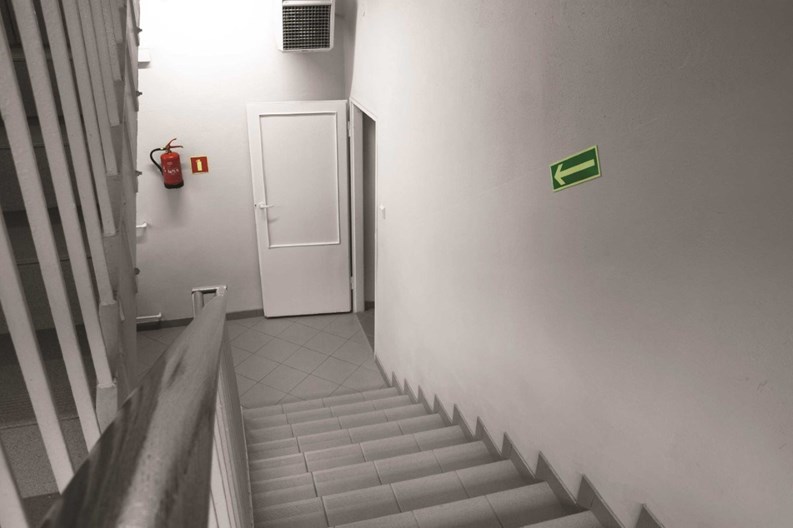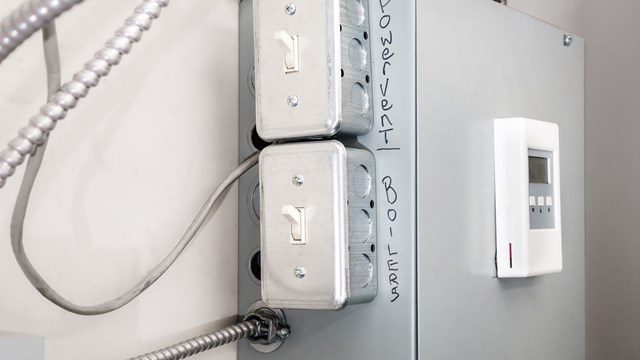Stairwell safety may not get front and center attention from condo associations but should not be side-stepped. In the event of a fire, it’s important for stairwells to be well lit with access to the exit. If an elderly person slips and falls and breaks a hip, the injured party may suffer serious, even life-threatening injury and the condo association may be liable for a considerable amount of damages.
Attorney Frank Flynn of the law firm of Downing & Flynn in Boston, Massachusetts, has experience in personal injury law and represents condos in personal injury claims. Recently Flynn successfully defended a condo association against a personal injury claim. “The case was dismissed because the injured party fell on steps in the common areas and sued the individual owners instead of the association. If the plaintiff had sued the association, the insurance company could have defended the interests of the association,” says Flynn. He points out that it’s important for the association to know its rights and responsibilities as well. “You wouldn’t want an individual owner taking responsibility for repair of a common area step. That’s the legal responsibility of the association,” says Flynn.
“Associations need to ensure that stairwells conform to both building and sanitary code standards,” says Flynn. “The building code requires that the stairwells are built correctly in conformity with the code at the time they were constructed. The sanitary code requires that the stairwells be kept up and not fall into disrepair.”
“The state code has some specific requirements for stairwell safety,” says Ralph Noblin, a consulting engineer and principal of Noblin & Associates in Bridgewater, Massachusetts. For example, there are strict limitations on the differential in stair riser heights. There should be no more than a 3/16 inch differential between one riser to the next and no more than a 3/8 inch difference between any two risers in a set of stairs.
Flynn points out it’s important for stairs to have friction to prevent slip and fall injuries. Noblin, who has consulted in slip and fall cases for condos, concurs. “A non-skid surface can be accomplished with treads or sandpaper,” he explains.
Meeting the Code
Stairwell safety involves more than stairs and prevention of slip and fall injuries. Fire prevention is a major safety component. Stairwell walls need to be built with fire-resistant material. A fire in a stairwell wall can obstruct the ability of residents to exit safely. “Most stairways, ”says Noblin, “need to have a one- to two-hour rating, meaning that it should take between one and two hours before a fire spreads from inside to outside a wall. Other problems with walls can include water leaks and mold. New buildings are contracted with cement walls as a preventive measure. Sheetrock walls can be a problem for mold if there is prolonged water leakage.”
The Massachusetts Building Code was enacted in the 1970s. “We are currently on the eighth revised edition,” says Noblin. “Newer structures must conform to the updated building code.”
One requirement of new construction is building access. David Kessler of Kessler McGuiness & Associates, an architectural firm in Newton, Massachusetts, refers to the requirements under 521 CMR of the Massachusetts Building Code. His company acts as a consultant for multi-family buildings including condos regarding access for people with disabilities. The requirements, however, can impact and benefit people with a range of abilities. “Under 521, stairwells in new buildings must be code-compliant even if there is an elevator,” says Kessler. He points out that the design of risers, treads and handrails must be compliant. There must be clear maneuverability space, according to Kessler, including a clear space for push and pull of stairwell doors. The objective is clear accessibility to entrance and egress to new buildings, including condos.
Noblin indicates that for older buildings, it may be difficult for the construction to conform to all the requirements of the current building code. However, once there is a need for a repair or a rebuild—for example, if a structure is damaged by fire—the repair or rebuild must conform to the updated code. A notable change to the code occurred in 1978, after major fire occurred in a building in Boston, resulting in the collapse of a fire escape. A newspaper photo captured a woman with an infant child falling from the fire escape. The child survived but the woman died. “Since that tragedy, the code has been changed to require inspections of all exterior stairwells every five years,” says Noblin.
Managers Play a Role, Too
Management companies play a key role in inspection and maintaining stairwell safety. Dan Rivers is the director of G&G Management Company in Newton, Massachusetts, which manages 92 condo associations in Greater Boston, Weymouth, Worcester and Rhode Island. “We do a thorough inspection of our buildings on a regular basis,” says Rivers. “During these visits, we inspect all stairwells for trip hazards—carpeted and wooden stairs especially, as a carpet could tear and cause someone to catch their shoe and fall. We also pay attention to the railings, as these can come loose and potentially be the cause of a fall in a stairwell.”
Jim Collett has been president of Essex Management Group in Haverhill, Massachusetts, for the past 23 years. The company manages the buildings of 27 associations located just outside Boston, including Chelsea, Revere, Medford and southern New Hampshire. Many of the buildings were formerly mills and have concrete stairways integrated into the halls. Collett agrees that routine inspection is the key to stairwell safety.
There is very little need for maintenance inside hallways, he notes, other than stair treads. “Outdoor stairwells require more maintenance because of weather,” says Collett. However, he says that maintenance is not a big expense and is not neglected by associations.
For security and safety, both companies make sure that hallways are well lit. They do control checks of the property and respond to any calls about any owner’s concerns.
One issue that does occasionally occur, according to both managers, is that a resident will leave personal property like shoes or umbrellas near their door, which can obstruct the pathway of other residents. Managers say they are able to treat the issue in a low-key manner by informing residents that they should not treat common areas as their personal space because of safety concerns.
While a considerable amount of stairwell safety is done with old-fashioned materials and products like concrete stairs and metal railings, there is a new product that is gaining popularity and could become more widespread in condo buildings, according to Terry Fagan, manager of business development at Volk Corporation, headquartered in Farmington Hills, Michigan. Volk Corporation has the rights to distribute Stainglow Safety Products, which makes a photo-luminescent safety strip which can be seen in the dark. The strip is made of strontium aluminate, a natural pigment that glows in the dark.
The safety strips can be placed on steps, railings and exit doors. For steps in condos, they can be made in strips six-inches-long and three-inches-wide and placed on the left and right sides of each stair. “They can be useful when the electricity goes out in a building,” says Fagan, and are less expensive than having a generator to supply lighting to the stairwell. Also, the strips can be a lifesaver in a fire, when stairways and exit doors can’t be seen because of smoke.”
“After the 1993 World Trade Center bombing, the building was fitted with photo-luminescent strips on the stairwells,” says Fagan. “A little-known fact is that during 9/11 a lot of people were able to get out of the Trade Center who wouldn’t have done so without the help of the strips.” In 2004, New York City passed a law, known as Local Law 26, which took effect in 2006 and requires every commercial and office building over five stories to be equipped with photo-luminescent strips. In 2009, the International Fire Code adopted an advisory recommending photo-luminescent strips for fire safety.
Most of Fagan’s clients own large buildings, particularly sports arenas, which require the evacuation of thousands of people in a fire. Clients include the Dallas Mavericks and Atlanta Hawks basketball teams. But the luminescent strips are starting to pique interest with condo associations—particularly those with multi-story buildings—which he predicts will be interested in them as they become better known.
With stairwell safety, the best advice to condo associations is to watch your step.
Leonard Golder is a freelance writer and a frequent contributor to New England Condominium.







Leave a Comment